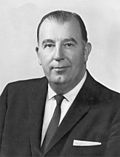| |||||||||||||||||
| |||||||||||||||||
 County results Randolph: 50–60% 60–70% 70–80% 80–90% Underwood: 50–60% 60–70% 70–80% | |||||||||||||||||
| |||||||||||||||||
| Elections in West Virginia |
|---|
 |
The 1960 United States Senate election in West Virginia was held on November 8, 1960. Incumbent Democratic U.S. Senator Jennings Randolph won re-election to a full term, defeating Republican Governor Cecil H. Underwood in a landslide.

